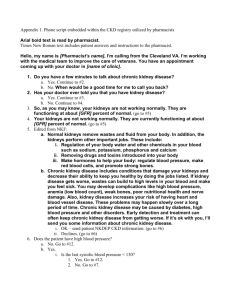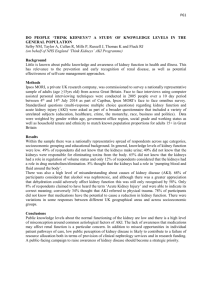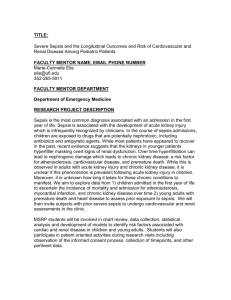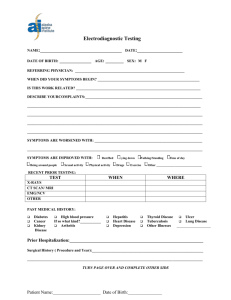Acute and Chronic Kidney Disease
advertisement
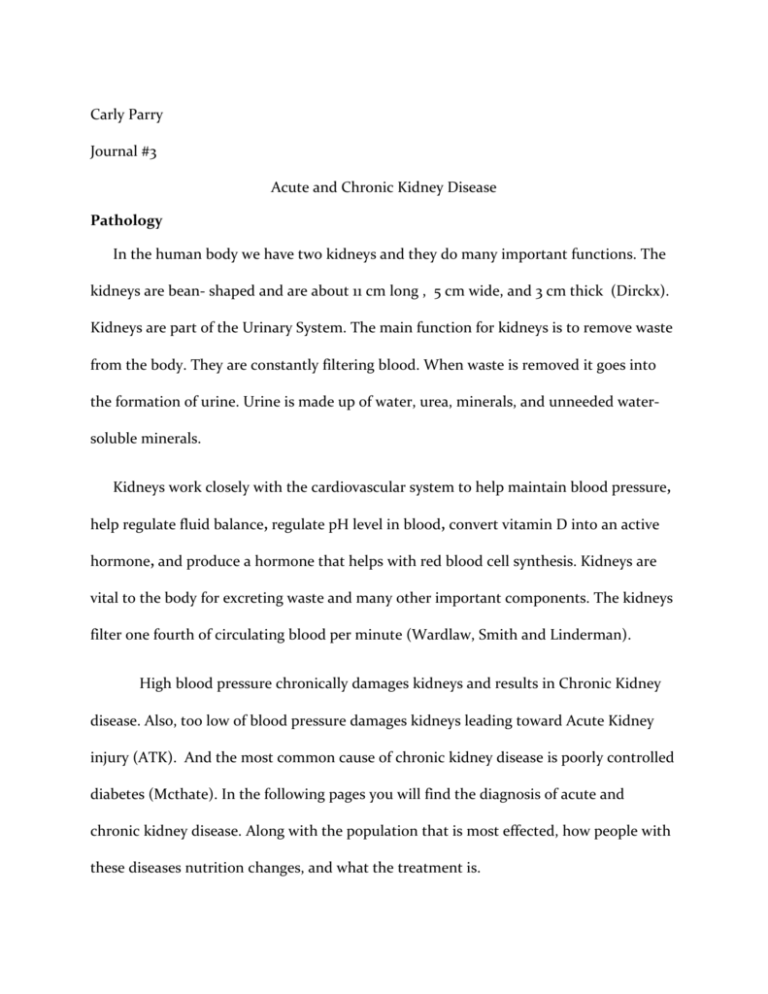
Carly Parry Journal #3 Acute and Chronic Kidney Disease Pathology In the human body we have two kidneys and they do many important functions. The kidneys are bean- shaped and are about 11 cm long , 5 cm wide, and 3 cm thick (Dirckx). Kidneys are part of the Urinary System. The main function for kidneys is to remove waste from the body. They are constantly filtering blood. When waste is removed it goes into the formation of urine. Urine is made up of water, urea, minerals, and unneeded watersoluble minerals. Kidneys work closely with the cardiovascular system to help maintain blood pressure, help regulate fluid balance, regulate pH level in blood, convert vitamin D into an active hormone, and produce a hormone that helps with red blood cell synthesis. Kidneys are vital to the body for excreting waste and many other important components. The kidneys filter one fourth of circulating blood per minute (Wardlaw, Smith and Linderman). High blood pressure chronically damages kidneys and results in Chronic Kidney disease. Also, too low of blood pressure damages kidneys leading toward Acute Kidney injury (ATK). And the most common cause of chronic kidney disease is poorly controlled diabetes (Mcthate). In the following pages you will find the diagnosis of acute and chronic kidney disease. Along with the population that is most effected, how people with these diseases nutrition changes, and what the treatment is. Common People That Are Diagnosed Anyone can have chronic or acute kidney disease, but these ethnic groups are more prone to develop these diseases. Caucasians that are overweight or who have Atherosclerosis- is the artery going to the kidneys- is more prone to having these diseases. Diabetic Polynesians especially women are more likely to get chronic or acute kidney disease because of their culture. The Polynesian culture likes their women to be prosperous. A bigger woman means she is well loved and prospers. Asians and Latinos are more susceptible to getting one of these diseases because they don’t manage their diabetes or blood pressure (Campbell). Causes of Acute Kidney Disease Acute kidney disease is reversible and patients do get better it is just a matter time. Symptoms may include; body swelling, problems concentrating, diarrhea, abdominal pain, fatigue, lethargy, confusion, and decreased urine production. There are 3 stages of Acute Kidney Injury (AKI): 1. Prerenal: Dehydration occurs There isn’t any blood supply to the kidneys. Hemorrhaging starts Heart failure occurs 2. Intrarenal: Acute Tubularnecgrosis Malignant hypertension: Means you have high blood pressure. Eg. 240/110 There is damage to the Glomerulus. 3. Postrenal: Kidney stones appear Bladder tumor: Which means there is urtial obstructer. Enlarged prostate Diagnosis of Acute Kidney Disease Many people don’t feel or even notice symptoms of Acute Kidney Failure. It is normally noticed in blood or urine tests. Those tests may be ordered for other reasons while people are in the hospital. Most of the time, it is diagnosed when the results come back. If the laboratory results are unsure they can do an ultra sound on the kidneys and bladder to look for renal failure. The amount and color of urine excreted is another sign that something may be wrong with the kidneys (Cunha). Treatment for Acute Kidney Disease After being treated at the hospital patients are recommended to see a Nephrologist. They are also given foods a list of that they should and shouldn’t eat to help with their situation. The patient’s doctor will recommend foods that should be limited. Healthy kidneys get rid of protein waste products, extra minerals, and fluid your body doesn’t need. Some foods that patients should limit include: beef, eggs, pork, lamb, wild game, milk, soy milk, yogurt, poultry, and cheese. Those are just to name a few of the things to limit. The special food charts are broken up for each food category on the food pyramid. For example, vegetables are broken up into low, medium, and high potassium categories. The doctor will limit each category of the food pyramid for the patient. So it will result in a faster healing process (Cunha). Causes of Chronic Kidney Disease Chronic kidney disease is progressive and irreversible. The causes of this are: hypertension and diabetes .Glomerulonephritis the kidneys are less capable of filtering toxins. Potassium and phosphate levels in the body increase while calcium levels decrease. They also become anemic. Diagnosis for Chronic Kidney Disease Anyone is at risk for chronic kidney disease. People should be tested regularly in order to prevent kidney disease. Tests can be done to check for this disease. For example, urinalysis, twenty-four hour urine tests, glomerular filtration rate, blood tests, blood cell counts, and biopsy. Symptoms may be need to urinate frequently at night, fatigue, weakness, loss of appetite, nausea, itching, easy bruising, and pale skin (Cunha). Treatment for Chronic Kidney Disease There are diet restrictions for patients. Patients may need to lose excess weight or stop smoking. If the kidneys are too damaged then patients may be put on dialysis or on a waiting list for a kidney transplant. Patients that have to be on dialysis are on it until they pass away or if they get a kidney transplant. Getting a kidney transplant is good for the patient who is receiving it. On the other hand the donor if they are still alive, have a harder and longer recovery period (Campbell). There are many dietary restrictions for patients who have chronic kidney disease. Meal plans help control the levels of sodium, potassium, and phosphourus in the body. It will help prevent bone loss and it will preserve good nutrition status for many patients. Limits are put on protein choices on animal protein foods. Fruits, vegetables, grains, and dairy products are limited and are low-potassium, medium potassium or high potassium. For example for fruits on a low potassium diet: apples, blackberries, fruit cocktail, papayas, plums, and raspberries. Those are just to name a few. Vegetables were also limited to carrots bean sprouts onions radishes (Cunha). Patients need to follow these restrictions in order to get well again or to help them not get any worse in their condition. Getting regular checkups allows the doctors to keep patients healthy and happy. There are some medications that chronic kidney disease patients should avoid. For example Aspirin, Ibuprofen, Laxatives and antacids containing magnesium, Zantac, Ranitidine, Alka Seltzer, Sudafed, Herbal medications (Cunha). Avoiding these medications will help patients stay healthy. Works Cited Campbell, Heather APRN. Chronic and Acute Kidney Disease Carly M. Parry. 13 November 2012. Interview. Cunha, John D. Acute and Chronic Kidney Failure Diagnosis and Treatment. 20 November 2012. Web. 20 November 2012. Dirckx, John H. Stedman's Concise Medical Dictionary For The Health Professions. Baltimore, MD: Williams and Wilkins A Waverly Company, 1997. Book. Marian, A and G Hardy. Biochemical and Nutrient Issue. 2003. Document. 13 November 2012. Mcthate, Hugther. Pathophysicology. n.d. Book. Wardlaw, Gordon M., Anne M. Smith and Alice K. Linderman. Contemporary Nutrition A Functional Approach. The McCgraw-Hill Company, 2012. Book.






